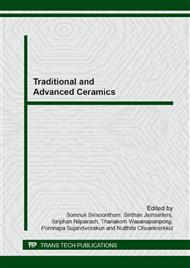p.79
p.85
p.91
p.97
p.103
p.108
p.114
p.122
p.127
Utilization of Rice Husk Ash and Waste Sludge from Cutting Glass Manufacturing with Angthong Pottery
Abstract:
Efficiently utilization of rice husk ash (RHA) and waste sludge from cutting glass manufacturer (WSG) as additives to pottery clay would yield positive economic impacts, such as more friendly industrial ecosystems. In this study, The RHA and WSH were used as additives to Angthong pottery clay (APC) and casting and fired properties were examined. Two sets of sample with a mixture consisting of 60% APC, 20% RHA, and 20% WSG (CRG formula) and non-added clay (C100 formula) were prepared by slip casting technique. Samples were fired at temperature 900 °C and 1100°C; then the viscosity of slurry, linear shrinkage, water adsorption, and 3-point bending strength were measured. The results showed that the optimum viscosity for slip casting of CRG and C100 were 1638 cP and 983 cP, respectively. The water adsorptions of all samples decrease while their shrinkage and strength increase with temperature. At 900°C, the water adsorption and the strength of CRG were 32% and 1184 psi, respectively. Comparatively, CRG’s water absorption was 1.5 times higher than C100’s, while their mechanical strength was insignificantly different. This due to the RHA behaves as pore forming and the WSG promotes the sintering of samples.
Info:
Periodical:
Pages:
103-107
Citation:
Online since:
April 2014
Keywords:
Price:
Сopyright:
© 2014 Trans Tech Publications Ltd. All Rights Reserved
Share:
Citation:


